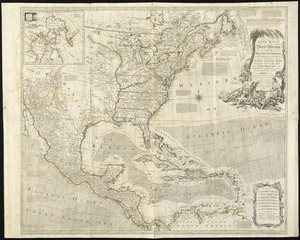By the middle of the 1700s, the thirteen British colonies which would become the United States stretched more than 1,200 miles along the Atlantic Coast from Georgia to Maine. Since the founding of Virginia in 1607, these colonies had become integral to the expanding British Empire. The four maps in this set each tell a part of the story of this time period.
The 1675 map of New England by John Seller (Map 1) shows a visible Native American presence as well as the range of English settlement. Images of warfare between Native Americans and settlers point to the fact that this map was drawn during the period of King Philip’s War (1675-1676), the last attempt by the Native Americans of southern New England to drive out the English. A larger percentage of the population was killed in that bloody conflict than in any other war in American history, and it dealt a devastating blow to Native communities.
Three major rivers cross Seller’s map: the Hudson, Connecticut, and Merrimack. A 1740 map by Emanuel Bowen (Map 2) shows another part of the known world of the English settlers in the mid 1700s: the Atlantic Ocean. The map represents courses charted by ships going to and from the West Indies from the coasts of Europe and Africa, the Canary Islands and Azores, and the eastern seaboard of North America. Both maps are reminders of the importance of water and land in the development of colonial America. The West Indies, the islands in the Caribbean mistakenly named by Columbus when he thought that he had reached the Far East, play a major role in Britain’s empire. An investigation of the title page of the Thomas Jefferys West India Atlas shows many clues about the importance of these islands to the economic power of Britain.
France and England were fighting for control of North America and maps show us changing boundaries. A global conflict, the Seven Years’ War, had erupted between these two European powers in 1755. The part of the conflict between 1754 and 1763 that fought for control of North America was known as the French and Indian War. The Samuel Blodget map (Map 3) shows one of the battles of that war fought in 1755 near Lake George in New York.
Britain’s victory in the French and Indian War greatly expanded her empire in North America. Under the 1763 Treaty of Paris, Britain acquired most of France’s territory in eastern Canada, Spanish-held Florida, and Native American lands (see the 1763 Delarochette map of North America, Map 4). Subsequently, the British military had to map these unfamiliar areas and garrison troops in frontier regions to protect the new territorial acquisitions. Parliament levied new taxes (such as the Stamp Act of 1765) to pay for the cost of the war and defense of the colonies. These efforts gradually strained relations between the colonists and London. Another war broke out in 1775. This time, British colonists would take up arms against their own government.
The 1675 map of New England by John Seller (Map 1) shows a visible Native American presence as well as the range of English settlement. Images of warfare between Native Americans and settlers point to the fact that this map was drawn during the period of King Philip’s War (1675-1676), the last attempt by the Native Americans of southern New England to drive out the English. A larger percentage of the population was killed in that bloody conflict than in any other war in American history, and it dealt a devastating blow to Native communities.
Three major rivers cross Seller’s map: the Hudson, Connecticut, and Merrimack. A 1740 map by Emanuel Bowen (Map 2) shows another part of the known world of the English settlers in the mid 1700s: the Atlantic Ocean. The map represents courses charted by ships going to and from the West Indies from the coasts of Europe and Africa, the Canary Islands and Azores, and the eastern seaboard of North America. Both maps are reminders of the importance of water and land in the development of colonial America. The West Indies, the islands in the Caribbean mistakenly named by Columbus when he thought that he had reached the Far East, play a major role in Britain’s empire. An investigation of the title page of the Thomas Jefferys West India Atlas shows many clues about the importance of these islands to the economic power of Britain.
France and England were fighting for control of North America and maps show us changing boundaries. A global conflict, the Seven Years’ War, had erupted between these two European powers in 1755. The part of the conflict between 1754 and 1763 that fought for control of North America was known as the French and Indian War. The Samuel Blodget map (Map 3) shows one of the battles of that war fought in 1755 near Lake George in New York.
Britain’s victory in the French and Indian War greatly expanded her empire in North America. Under the 1763 Treaty of Paris, Britain acquired most of France’s territory in eastern Canada, Spanish-held Florida, and Native American lands (see the 1763 Delarochette map of North America, Map 4). Subsequently, the British military had to map these unfamiliar areas and garrison troops in frontier regions to protect the new territorial acquisitions. Parliament levied new taxes (such as the Stamp Act of 1765) to pay for the cost of the war and defense of the colonies. These efforts gradually strained relations between the colonists and London. Another war broke out in 1775. This time, British colonists would take up arms against their own government.


















![The West Indian atlas [frontispiece]](https://bpldcassets.blob.core.windows.net/derivatives/images/commonwealth:3f462x83x/image_thumbnail_300.jpg)